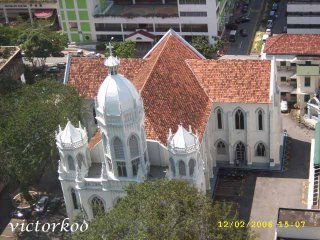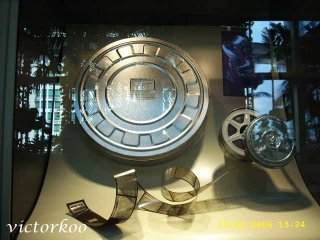 On 12 Feb 2006, I visited the spanking new National Library at 100 Victoria Street. It was my first visit since the library was opened to the public on 22 Jul 2005. I wanted to see for myself how different the new library was from the old red-brick one at Stamford Road.
On 12 Feb 2006, I visited the spanking new National Library at 100 Victoria Street. It was my first visit since the library was opened to the public on 22 Jul 2005. I wanted to see for myself how different the new library was from the old red-brick one at Stamford Road.It might not be obvious from the above photo but the 16-storey building actually consisted of two 16-storey blocks linked by 'sky-bridges' on every level. It certainly looked very modern and imposing from the outside, a far cry from the humble National Library of yesteryear.
Inside, the first floor lobby was no less impressive. In fact, I thought that it resembled the lobby of a 5-star hotel:
 Every floor of the library had a pair of escalators but most of them did not appear to be working:
Every floor of the library had a pair of escalators but most of them did not appear to be working:
However, I found out why soon enough - I stepped onto one and nearly fell forward when the escalator suddenly moved backward. So the escalators had a power-saving feature which shut them down when they were not in use for some time. How suaku of me! Not only that, I had stepped onto the wrong one - there were actually tiny directional traffic signs beside each escalator:
 I certainly was not aware that one needed a pass in the highway code in order to use the escalator safely. So paiseh, even though I had passed my highway code some 3 decades ago, I had failed to notice the tiny signs (must be my failing eyesight). If I had fallen and injured myself, I would definitely become the laughing stock of friends like Chris for getting myself injured while engaging in an activity as innocuous as a library visit. Luckily not many
I certainly was not aware that one needed a pass in the highway code in order to use the escalator safely. So paiseh, even though I had passed my highway code some 3 decades ago, I had failed to notice the tiny signs (must be my failing eyesight). If I had fallen and injured myself, I would definitely become the laughing stock of friends like Chris for getting myself injured while engaging in an activity as innocuous as a library visit. Luckily not many I went up to the 14th floor which was as high up as I could venture. The glass windows at the lobby offered a panaromic bird's eye view of the city. One could see as far as Orchard Road or as near as the next building, St Joseph's Church:
 On the day of my visit, the library was a hive of activities. There was even an opera performance at the Plaza which was part of Lovebites 2006, a charity event held in aid of the Association of Persons with Special Needs (APSN):
On the day of my visit, the library was a hive of activities. There was even an opera performance at the Plaza which was part of Lovebites 2006, a charity event held in aid of the Association of Persons with Special Needs (APSN): (Frannxis, an avid Cantonese opera fan whom I knew in blogosphere, would have been delighted. However, although I was not sure what language they were singing in, I was certain it was not Cantonese.) Besides talks, workshops and performances, there were several exhibitions which were held concurrently, including:
(Frannxis, an avid Cantonese opera fan whom I knew in blogosphere, would have been delighted. However, although I was not sure what language they were singing in, I was certain it was not Cantonese.) Besides talks, workshops and performances, there were several exhibitions which were held concurrently, including:1 Zheng He (Admiral Cheng Ho):
 2 Dream of the Red Chambers;
2 Dream of the Red Chambers;3 Singapore Literary Pioneers Gallery (permanent exhibition on Level 11); and
4 From Books to Bytes: The Story of the National Library (permanent exhibition on Level 5)
I visited the last 2 exhibitions and gawked at several antiques which brought back nostalgia for me. Among the items were:
A Remington typewriter with fountain pen and ink bottle:
 The personal computer has largely replaced the functions of the typewriter, fountain pen and ink.
The personal computer has largely replaced the functions of the typewriter, fountain pen and ink.A red brick:
 At least 5,000 of such bricks were retained from the old building in 2004 and now form part of a wall in the basement garden of the Library at Victoria Street. The bricks were baked at the Alexandra Brickworks factory, with clay from Jurong.
At least 5,000 of such bricks were retained from the old building in 2004 and now form part of a wall in the basement garden of the Library at Victoria Street. The bricks were baked at the Alexandra Brickworks factory, with clay from Jurong.A book press:
 This press was used in the book binding unit located in the basement of the Stamford Road National Library. Library staff were required to repair and strengthen books and periodicals through careful sewing and binding by hand. Notice that the book press was made in London and imported by a Singapore company located in Kling Street:
This press was used in the book binding unit located in the basement of the Stamford Road National Library. Library staff were required to repair and strengthen books and periodicals through careful sewing and binding by hand. Notice that the book press was made in London and imported by a Singapore company located in Kling Street:
 (Extract from singlishdictionary.com: "Chulia Street, called Kling Street once because Indians from southern India, known as 'men from Kalinga', or orang kling in Malay, lived there. Kalinga, an ancient southern Indian state, was corrupted into kling long before Indians arrived in Malaya. By 1918, however, kling had become derogatory, so Kling Street was changed to Chulia Street, with nobody seeming to mind that Chulia was just the northern Indian term for Kalinga".)
(Extract from singlishdictionary.com: "Chulia Street, called Kling Street once because Indians from southern India, known as 'men from Kalinga', or orang kling in Malay, lived there. Kalinga, an ancient southern Indian state, was corrupted into kling long before Indians arrived in Malaya. By 1918, however, kling had become derogatory, so Kling Street was changed to Chulia Street, with nobody seeming to mind that Chulia was just the northern Indian term for Kalinga".)
Microfilm, microfiche and reels of film:
 According to the explanatory notes, these technologies appeared in the 1960s and 1980s. Microfilm and microfiche technologies are some of the more stable means of preserving information in today's information age. (No kidding? Can they be more stable than my computer hard disk and CD-Rs which I use to store my data?)
According to the explanatory notes, these technologies appeared in the 1960s and 1980s. Microfilm and microfiche technologies are some of the more stable means of preserving information in today's information age. (No kidding? Can they be more stable than my computer hard disk and CD-Rs which I use to store my data?)
The library still had plenty of the traditional stuff:
 But self-service terminals had largely replaced the traditional staff:
But self-service terminals had largely replaced the traditional staff:
 Even so, my unequivocal verdict was that the new library had a much more pleasant and conducive learning environment compared to the old one. You should visit it soon if you have not done it yet. I am sure that you will find the experience as fulfulling as I did. Do be extra careful when using the escalators though.
Even so, my unequivocal verdict was that the new library had a much more pleasant and conducive learning environment compared to the old one. You should visit it soon if you have not done it yet. I am sure that you will find the experience as fulfulling as I did. Do be extra careful when using the escalators though.






6 comments:
Thanks for the warning. Why didn't u put up a suggestion in their suggestion box that they issue helmet + elbow and knee guards like those they use for roller-blading.
Victor, rest assured you are not the only Suaku in this part of the word. I visited Tampines Library recently (yeah, so behind time I am), and was delighted to learn how quick it took me to locate the book I wanted with the computer catalogue system they have in place. With a click of a three, I mean one button, and I found the book in all of 5 minutes! In the past, we had to go through the tedious process of opening drawers after drawers of catalogue in cardboard form just to look for the book we wanted.
Fret not about the lack of in-house doctors at the library, Victor. Isn't Wilmar Clinic just round the corner? LOL
The folly of man! And the fond memories a piece of red brick could evoke!
I even more suaku. Only found out about it this month. Have yet into step it. Doesn't look like a library to me - seriously.
After reading your report I think I will pay it a visit whether got opera show or not.
Hee..hee..I used those typewriter, fountain pen and Parker ink before.
I find those antique objects put up by the library boring. Now what would really interest me are antique ice-shaving machines - you know, the type for making ice kachangs; or the manual coconut grinding tools. Anyone know where I can find these. I will blog about it one of these days.
Chun See, I have a good friend (not Chris) who's an avid antique collector. Remember one of my early posts about my old camera which I gave to him? I remember he has an antique ice kachang machine, i.e. the cast iron type with the manual wheel-handle and not the 1st generation 'wooden- stool' type used by the Indian ice-ball seller. If it is the wooden kind you are looking for, I am afraid that it may be a very rare and difficult find now.
I may be meeting this friend in the next week or so. If so, I will try to snap a few photos for you. Will risk life and limb for a friend anytime :).
As for coconut grating machine, so sorry I don't know of any possible resources.
Post a Comment